Scottish Art News
Latest news
Magazine
News & Press
Publications
The Jewels in the Crown
By Rachael Cloughton, 07.02.2022

To mark the Queen's Jubilee, Scottish Art News presents some of our favourite paintings of royal residences in Scotland, from Holyrood Palace to The Balmoral Estate...
David Wilkie, The Entrance of George IV at the Palace of Holyroodhouse, 1828
Holyrood Palace is a spectacular backdrop for David Wilkie's theatrical painting of George IV's arrival in Edinburgh in 1822. This painting, created six years after the event, is held in the National Galleries of Scotland collection and is a preparatory study for a larger panel at Holyrood. There is also a preparatory watercolour sketch by Wilkie from 1822 in the Fleming Collection.
Louis Jacques Mande Daguerre, Ruins of Holyrood Chapel, c.1825
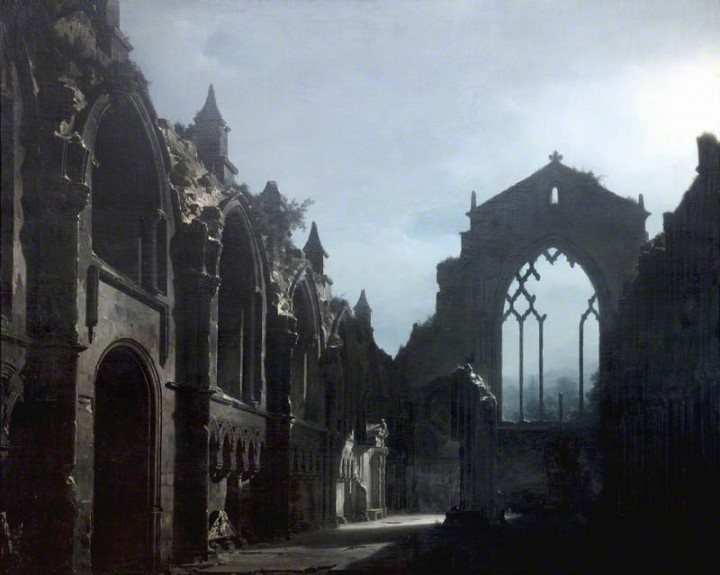 Louis Jacques Mande Daguerre, Ruins of Holyrood Chapel, c.1825. National Museums Liverpool, Walker Art Gallery.
Louis Jacques Mande Daguerre, Ruins of Holyrood Chapel, c.1825. National Museums Liverpool, Walker Art Gallery.
While Wilkie was preparing his royal painting of pomp and pageantry at Holyrood Palace, the French artist Louis Daguerre was creating this more austere image of the neighbouring Holyrood Chapel. Most famous for his invention of the eponymous daguerreotype photography, Daguerre also created the diorama and it is thought this device could have informed the artist's dramatic rendering of light in this painting. Curators at Liverpool's Walker Art Gallery, where the work is now held, write, 'if the painting was made after the production of the same scene in a diorama, we can assume the diorama enabled the artist to study carefully the affect of light on the ruins and capture them successfully in the painting.'
David Young Cameron, Holyrood Palace, c. 1896
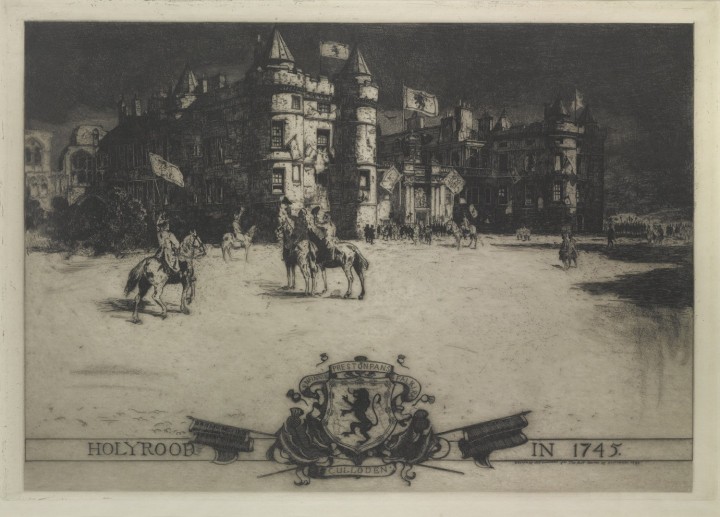 DY Cameron, Holyrood Palace, c. 1896. The Fleming Collection.
DY Cameron, Holyrood Palace, c. 1896. The Fleming Collection.
Today D Y Cameron is remembered as a painter of Scottish landscapes. However his ouevre includes portraits, townscapes and architectural subjects, and it was as an etcher that he first came to prominence. Over a period of 45 years he produced around 520 etchings and drypoints, including this atmospheric image of Holyrood Palace in the Fleming Collection. His prolific output and mastery of light and shade made him one of the foremost British artists of the Etching Revival of 1880-1930, alongside fellow Scots Muirhead Bone and James McBey. In 1933 Cameron was appointed King's Painter and Limner in Scotland.
Aleksander Żyw, Holyrood Palace, 1940
 Aleksander Żyw, Holyrood Palace, 1940. Courtesy of the University of St Andrews Libraries and Museums, ID: HC135.
Aleksander Żyw, Holyrood Palace, 1940. Courtesy of the University of St Andrews Libraries and Museums, ID: HC135.
Aleksander Zyw's painting of Holyrood Palace with Arthur's Seat in the background captures the extraordinary volcanic landscape that surrounds the royal residence. The view clearly made an impression on Zyw; created in 1940, it was one of the earliest paintings the artist made in Scotland, having arrived here in WWII following a dramatic escape from France to join the Polish forces who were regrouping in Edinburgh.
James Giles, A View of Balmoral, 1848
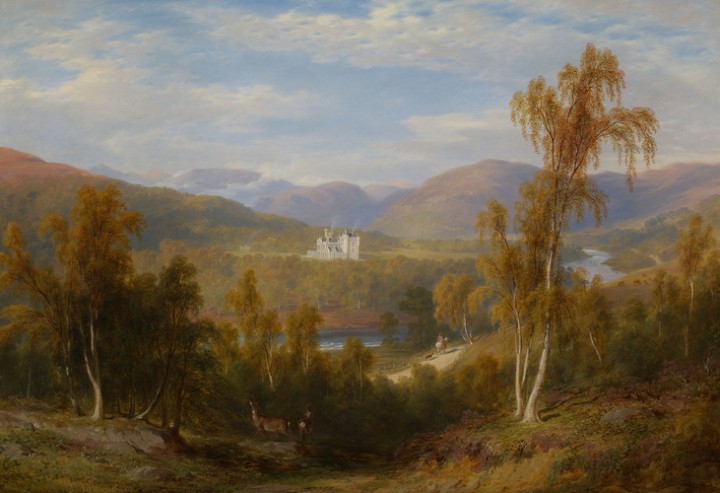 James Giles, A View of Balmoral, 1848. Royal Collection Trust.
James Giles, A View of Balmoral, 1848. Royal Collection Trust.
Prince Albert purchased the lease to Balmoral Castle in 1847. This painting by the Aberdonian landscape painter James Giles was created a year later and given to the Prince by Queen Victoria as a Christmas gift. The painting shows a view of the old castle from the east. It was, according to Queen Victoria, 'a pretty little castle in the old Scottish style'.
F Colebrooke Stockdale, Valley of the Dee, with Abergeldie Castle, 1853
 F Colebrooke Stockdale, Valley of the Dee, with Abergeldie Castle, 1853. Royal Collection Trust.
F Colebrooke Stockdale, Valley of the Dee, with Abergeldie Castle, 1853. Royal Collection Trust.
A year after buying the lease to Balmoral, Prince Albert purchased a 40 year lease of the Abergeldie Estate nearby. It was here that the Duchess of Kent stayed on her visits to Scotland in the 1850s. F Colebrooke Stockdale's watercolour captures the 16th century castle surrounded by rolling Highland Hills. Balmoral is just visible in the distance.
Queen Victoria, Ballater from the garden at Birkhall, 1868
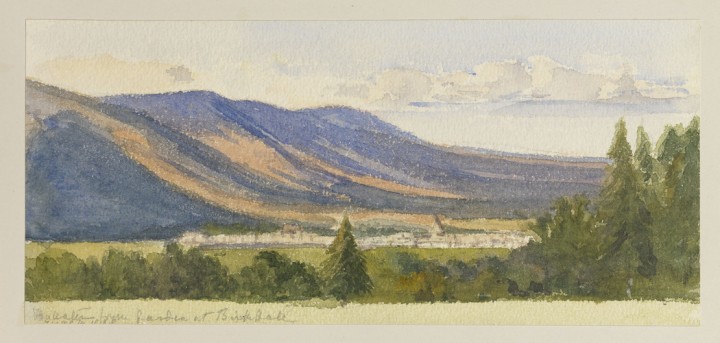 Queen Victoria, Ballater from the garden at Birkhall, 1868. Royal Collection Trust.
Queen Victoria, Ballater from the garden at Birkhall, 1868. Royal Collection Trust.
As well as being a great patron of the arts, Queen Victoria was also an accomplished painter, as this watercolour of Ballater from Birkhall demonstrates. Birkhall, which is located on the Balmoral Estate, is now the Scottish residence of Prince Charles and Camilla. In 2021 The Royal Collection Trust exhibited 'Victoria & Albert: Our Lives in Watercolour', which included many works by Queen Victoria in the Royal Collection. Read more in curator Carly Collier's feature for Scottish Art News.
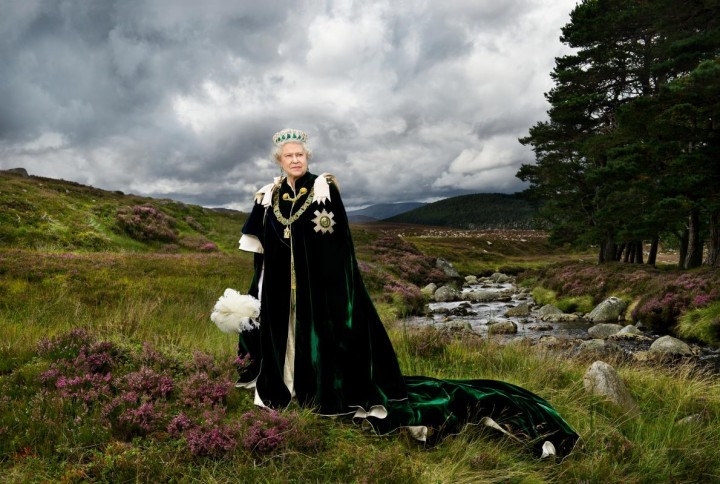 Julian Calder, Queen of Scots, Sovereign of the Most Ancient and Most Noble Order of the Thistle and Chief of the Chiefs, 2010. National Galleries Scotland. Bought with the aid of the Patrons of the National Galleries of Scotland 2013. © Julian Calder.
Julian Calder, Queen of Scots, Sovereign of the Most Ancient and Most Noble Order of the Thistle and Chief of the Chiefs, 2010. National Galleries Scotland. Bought with the aid of the Patrons of the National Galleries of Scotland 2013. © Julian Calder.
In 2010, Julian Calder chose the Gelder Burn on the Balmoral Estate as the location of his striking portrait of the Queen. Inspired by the great paintings by Sir Henry Raeburn, Calder's photograph presents the viewer with a formal portrait set against a highland backdrop.




